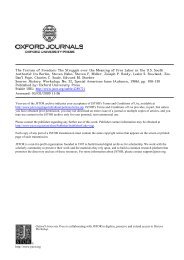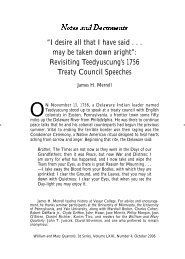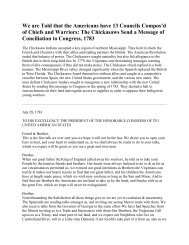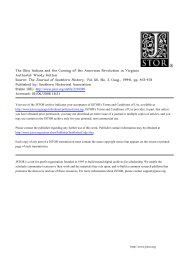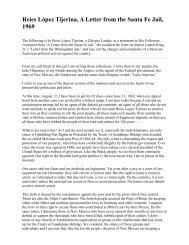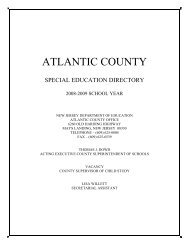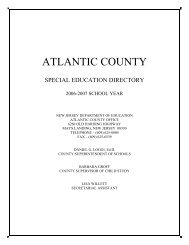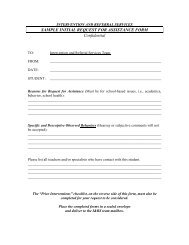A Historical and Regional Overview of Latinas in the United ... - CUNY
A Historical and Regional Overview of Latinas in the United ... - CUNY
A Historical and Regional Overview of Latinas in the United ... - CUNY
Create successful ePaper yourself
Turn your PDF publications into a flip-book with our unique Google optimized e-Paper software.
Introduction: A <strong>Historical</strong> <strong>and</strong> <strong>Regional</strong> <strong>Overview</strong><br />
vana, <strong>the</strong> Cuban Women’s Club sponsored luncheons,<br />
conferences, art exhibitions, <strong>and</strong> literary contests.<br />
Members were also <strong>in</strong>volved <strong>in</strong> local charities <strong>and</strong><br />
fund-rais<strong>in</strong>g activities, just as women <strong>of</strong> <strong>the</strong>ir social<br />
class were expected to be back <strong>in</strong> Cuba. By <strong>the</strong> mid-<br />
1970s, however, members dem<strong>and</strong>ed that <strong>the</strong> club do<br />
more than just organize social <strong>and</strong> charitable events.<br />
They wanted <strong>the</strong>ir club to address issues pert<strong>in</strong>ent to<br />
<strong>the</strong>ir careers <strong>and</strong> <strong>the</strong>ir new roles <strong>in</strong> U.S. society. By <strong>the</strong><br />
late 1970s, conferences addressed such issues as bil<strong>in</strong>gual<br />
education, vot<strong>in</strong>g <strong>and</strong> political representation,<br />
salaries, <strong>and</strong> <strong>the</strong> workplace. The CWC ceased to be an<br />
exclusively Cuban social club <strong>and</strong> counted more than<br />
300 members <strong>of</strong> various nationalities <strong>and</strong> pr<strong>of</strong>essional<br />
<strong>and</strong> educational backgrounds by 1980.<br />
Several bus<strong>in</strong>ess <strong>and</strong> pr<strong>of</strong>essional organizations<br />
also emerged <strong>in</strong> sou<strong>the</strong>rn Florida dur<strong>in</strong>g <strong>the</strong> 1970s <strong>and</strong><br />
1980s, reflect<strong>in</strong>g women’s permanent shift <strong>in</strong>to <strong>the</strong><br />
workplace. Groups such as <strong>the</strong> Comité de Mujeres <strong>Lat<strong>in</strong>as</strong>,<br />
<strong>the</strong> Lat<strong>in</strong> Bus<strong>in</strong>ess <strong>and</strong> Pr<strong>of</strong>essional Women’s Club<br />
(LBPWC), <strong>and</strong> <strong>the</strong> Coalition <strong>of</strong> Hispanic American<br />
Women (CHAW) were created by younger women,<br />
graduates <strong>of</strong> U.S. colleges <strong>and</strong> universities, who regarded<br />
<strong>the</strong>mselves as Cuban Americans. Whe<strong>the</strong>r at<br />
<strong>the</strong> local or national level, CHAW <strong>and</strong> <strong>the</strong> LBPWC addressed<br />
<strong>the</strong> problems all women <strong>in</strong> <strong>the</strong> U.S. workforce<br />
faced: unequal pay, <strong>in</strong>adequate child care, discrim<strong>in</strong>ation,<br />
<strong>and</strong> sexual harassment. Their workshops taught<br />
women strategies to achieve equal access to education,<br />
social services, <strong>and</strong> <strong>the</strong> judicial system. However,<br />
<strong>the</strong>y also discussed issues relevant to <strong>the</strong> larger Lat<strong>in</strong>o<br />
community such as bil<strong>in</strong>gual education, immigration<br />
reform, affirmative action, <strong>and</strong> domestic violence. Both<br />
organizations sponsored a scholarship program to<br />
help needy students attend college.<br />
The exile experience, thus forced women to exp<strong>and</strong><br />
<strong>the</strong>ir participation <strong>in</strong> labor, <strong>the</strong> economy, politics, <strong>and</strong><br />
<strong>the</strong> overall life <strong>of</strong> <strong>the</strong> community. To deal with <strong>the</strong><br />
problems <strong>and</strong> challenges <strong>of</strong> life <strong>in</strong> a new country, <strong>the</strong>y<br />
created social, familial, <strong>and</strong> pr<strong>of</strong>essional networks.<br />
Women reconciled <strong>the</strong> past with <strong>the</strong> present <strong>and</strong> promoted<br />
an appreciation <strong>of</strong> <strong>the</strong> Cuban cultural heritage<br />
while contribut<strong>in</strong>g to <strong>the</strong>ir families’ adaptation <strong>in</strong>to <strong>the</strong><br />
ma<strong>in</strong>stream. They helped create a strong <strong>and</strong> stable<br />
ethnic community with ties to two countries <strong>and</strong> two<br />
cultures.<br />
The Cuban population <strong>of</strong> sou<strong>the</strong>rn Florida is <strong>the</strong><br />
best known <strong>of</strong> <strong>the</strong> Lat<strong>in</strong>o/a populations <strong>of</strong> <strong>the</strong> sou<strong>the</strong>astern<br />
<strong>United</strong> States, but it is not <strong>the</strong> only group to<br />
have settled <strong>in</strong> this state <strong>and</strong> region. Even <strong>in</strong> Miami<br />
<strong>and</strong> Dade County, long considered a Cuban stronghold,<br />
that group no longer constitutes <strong>the</strong> numerical majority.<br />
A recent <strong>in</strong>flux from Central <strong>and</strong> South America,<br />
particularly from Nicaragua <strong>and</strong> Colombia, means that<br />
Cuban-accented Spanish is not <strong>the</strong> only form <strong>of</strong> <strong>the</strong><br />
24<br />
q<br />
language heard on <strong>the</strong> streets <strong>of</strong> sou<strong>the</strong>rn Florida.<br />
Puerto Ricans, Salvadorans, Dom<strong>in</strong>icans, Mexicans,<br />
<strong>and</strong> o<strong>the</strong>rs have also migrated to sou<strong>the</strong>rn Florida <strong>and</strong><br />
have established transnational economic <strong>and</strong> political<br />
connections that contribute to <strong>the</strong> city’s reputation as<br />
<strong>the</strong> “gateway to <strong>the</strong> Americas.” While Miami/Dade<br />
County was <strong>the</strong> most popular dest<strong>in</strong>ation <strong>of</strong> Lat<strong>in</strong>os,<br />
migration to o<strong>the</strong>r parts <strong>of</strong> <strong>the</strong> state also <strong>in</strong>creased. By<br />
1999 <strong>the</strong> Lat<strong>in</strong>o population <strong>in</strong> Florida stood at<br />
2,334,403.<br />
Elsewhere around <strong>the</strong> sou<strong>the</strong>astern <strong>United</strong> States,<br />
Lat<strong>in</strong>os have settled <strong>in</strong> towns <strong>and</strong> cities not traditionally<br />
associated with <strong>the</strong>ir populations. Some <strong>of</strong> <strong>the</strong>m<br />
are recent immigrants, legal or illegal; o<strong>the</strong>rs are contracted<br />
laborers who arrive with temporary visas; <strong>and</strong><br />
still o<strong>the</strong>rs are <strong>in</strong>ternal migrants who migrate from<br />
o<strong>the</strong>r areas <strong>of</strong> <strong>the</strong> country <strong>in</strong> search <strong>of</strong> better economic<br />
opportunities. The Lat<strong>in</strong>o/a population <strong>of</strong> Georgia is<br />
one <strong>of</strong> <strong>the</strong> fastest grow<strong>in</strong>g <strong>in</strong> <strong>the</strong> nation, doubl<strong>in</strong>g <strong>in</strong><br />
size <strong>in</strong> just one decade. Accord<strong>in</strong>g to estimates from<br />
<strong>the</strong> U.S. Census Bureau, <strong>in</strong> 1999 <strong>the</strong>re were 239,566<br />
Lat<strong>in</strong>os <strong>in</strong> Georgia, compared with 108,933 <strong>in</strong> 1990.<br />
Statistics for <strong>the</strong> Lat<strong>in</strong>o populations <strong>in</strong> 1999 <strong>in</strong> o<strong>the</strong>r<br />
sou<strong>the</strong>astern states <strong>and</strong> <strong>the</strong>ir percentage <strong>in</strong>crease<br />
s<strong>in</strong>ce 1990 <strong>in</strong>clude <strong>the</strong> follow<strong>in</strong>g: Alabama, 45,349<br />
(84.1 percent); Louisiana, 119,496 (28.4 percent); Mississippi,<br />
23,975 (49.9 percent); North Carol<strong>in</strong>a, 175,707<br />
(128.9 percent); <strong>and</strong> South Carol<strong>in</strong>a, 54,299 (78 percent).<br />
Apart from a few studies <strong>of</strong> agricultural <strong>and</strong> oil<br />
workers <strong>in</strong> <strong>the</strong> region, non-Cuban Lat<strong>in</strong>os <strong>of</strong> <strong>the</strong><br />
Sou<strong>the</strong>ast rema<strong>in</strong> one <strong>of</strong> <strong>the</strong> most understudied populations.<br />
SOURCES: Estrade, Paul. 1987. “Los clubes femen<strong>in</strong>os<br />
en el Partido Revolucionario Cubano (1892–1898).”<br />
Anuario del Centro de Estudios Martianos 10:175–201;<br />
Garcia, María Crist<strong>in</strong>a. 1994. “Cuban Women <strong>in</strong> <strong>the</strong><br />
<strong>United</strong> States.” In H<strong>and</strong>book <strong>of</strong> Hispanic Cultures <strong>in</strong> <strong>the</strong><br />
<strong>United</strong> States; Sociology. ed. Felix Padilla, 203–217.<br />
Houston: Arte Público Press; Pérez, Lis<strong>and</strong>ro. 1986.<br />
“Immigrant Economic Adjustment <strong>and</strong> Family Organization:<br />
The Cuban Success Story.” International Migration<br />
Review 20 (Spr<strong>in</strong>g): 4–21; Pérez, Louis A. 1978.<br />
“Cubans <strong>in</strong> Tampa: From Exiles to Immigrants, 1892–<br />
1901.” Florida <strong>Historical</strong> Quarterly 57 (October): 129–<br />
140; Prieto, Yol<strong>and</strong>a. 1984. “Re<strong>in</strong>terpret<strong>in</strong>g an Immigration<br />
Success Story: Cuban Women, Work, <strong>and</strong><br />
Change <strong>in</strong> a New Jersey Community.” Ph.D. diss., Rutgers<br />
University.<br />
María Crist<strong>in</strong>a García<br />
LATINAS IN THE PACIFIC NORTHWEST<br />
A historical overview <strong>of</strong> <strong>Lat<strong>in</strong>as</strong> <strong>in</strong> <strong>the</strong> Pacific northwestern<br />
states <strong>of</strong> Wash<strong>in</strong>gton, Oregon, <strong>and</strong> Idaho re-



